
Rittenhouse Square is the name of both a public park and the surrounding neighborhood that is also referred to as Rittenhouse in Center City, Philadelphia, Pennsylvania, United States. The park is one of the five original open-space parks planned by William Penn and his surveyor Thomas Holme during the late 17th century.

The Racquet Club of Philadelphia (RCOP) is a private social club and athletic club in Philadelphia, Pennsylvania. It has facilities for squash, real tennis, and racquets. The club is ranked in the Top 20 Athletic Clubs on the Platinum Club of America list.
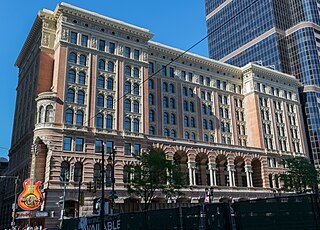
The Reading Terminal is a complex of buildings that includes the former Reading Company main station located in the Market East section of Center City in the city of Philadelphia, Pennsylvania, United States. It is composed of the Reading Terminal Headhouse, Trainshed, and Market.

Horace Trumbauer was a prominent American architect of the Gilded Age, known for designing residential manors for the wealthy. Later in his career he also designed hotels, office buildings, and much of the campus of Duke University. Trumbauer's massive palaces flattered the egos of his "robber baron" clients, but were dismissed by his professional peers. His work made him a wealthy man, but his buildings rarely received positive critical recognition. Today, however, he is hailed as one of America's premier architects, with his buildings drawing critical acclaim even to this day.
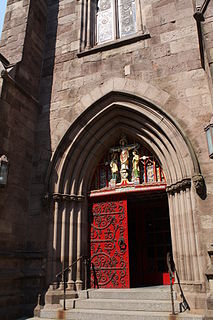
Saint Mark's Episcopal Church, at 1625 Locust Street in Rittenhouse Square, Center City, Philadelphia, Pennsylvania, is an Episcopal church in the Anglo-Catholic tradition. It is part of the Diocese of Pennsylvania.

Samuel Sloan was a Philadelphia-based architect and best-selling author of architecture books in the mid-19th century. He specialized in Italianate villas and country houses, churches, and institutional buildings. His most famous building—the octagonal mansion "Longwood" in Natchez, Mississippi—is unfinished; construction was abandoned during the American Civil War.

Wilson Eyre, Jr. was an American architect, teacher and writer who practiced in the Philadelphia area. He is known for his deliberately informal and welcoming country houses, and for being an innovator in the Shingle Style.

College Hall is the oldest building on the West Philadelphia campus of the University of Pennsylvania. Prior to its construction, the university was located on Ninth Street in Center City, Philadelphia. The building was designed by Thomas Webb Richards and completed in 1873. The characteristic green color of the building is due to its composition of green serpentine stone.

St. Augustine Catholic Church, also called Olde St. Augustine's, is a historic Catholic church in Philadelphia, Pennsylvania, United States. Consecrated in 1848, the Palladian-style church was designed by Napoleon LeBrun. It is listed on the National Register of Historic Places.

Historic RittenhouseTown, sometimes referred to as Rittenhouse Historic District, encompasses the remains of an early industrial community which was the site of the first paper mill in British North America. The mill was built in 1690 by William Rittenhouse and his son Nicholas on the north bank of Paper Mill Run near Philadelphia, Pennsylvania. The district, off Lincoln Drive near Wissahickon Avenue in Fairmount Park, includes six of up to forty-five original buildings. RittenhouseTown was listed on the National Register of Historic Places and was designated a National Historic Landmark District on April 27, 1992.
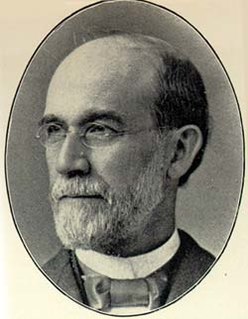
Addison Hutton (1834–1916) was a Philadelphia architect who designed prominent residences in Philadelphia and its suburbs, plus courthouses, hospitals, and libraries, including the Ridgway Library and the Historical Society of Pennsylvania. He made major additions to the campuses of Westtown School, George School, Swarthmore College, Bryn Mawr College, Haverford College, and Lehigh University.
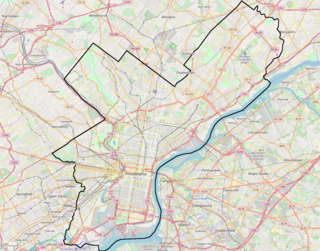
The Equitable Trust Building is a historic commercial skyscraper located at 1405 Locust Street in Philadelphia, Pennsylvania.
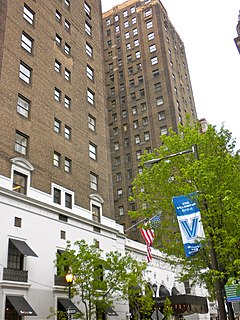
The Warwick is a historic hotel in the Rittenhouse Square neighborhood of Philadelphia, Pennsylvania.

The Drake Hotel, a historic 375-foot-tall, 33-story luxury hotel located at 1512–1514 Spruce Street at the corner of S. Hicks Street between S. 15th and S. 16th Streets in the Rittenhouse Square neighborhood of Philadelphia, Pennsylvania was built in 1928–29 by the Murphy, Quigley Company and was designed by the architectural firm of Ritter and Shay in the Art Deco style with Spanish Baroque terra cotta ornamentation on themes surrounding Sir Francis Drake, including "dolphins, shells, sailing vessels and globes." The building is topped by a terra cotta dome.

The Dr. Joseph Leidy House is a historic residence located at 1319 Locust Street between S. 13th and S. Juniper Streets in the Washington Square West neighborhood of Philadelphia, Pennsylvania. It was built in 1893-94 and was designed in the Georgian style by architect Wilson Eyre to be the home of Joseph Leidy, Jr., the nephew of Joseph Leidy (1823–1891), a noted American paleontologist with whom he is often confused. The house is next door to the Clarence B. Moore House, which was designed by Eyre in 1890. From 1925 to 1979, the Leidy House served as the clubhouse of the now-defunct Poor Richard Club, whose members worked in advertising, and with the Moore House next door, was part of the Charles Morris Price School of Advertising and Journalism. Currently, it is the headquarters of District 1199C, the National Union of Hospital and Health Care Employees.
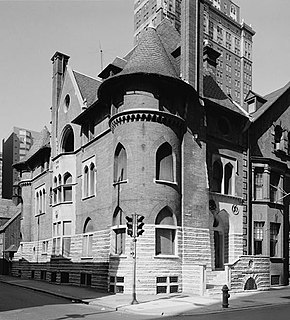
The Clarence B. Moore House is a historic home located at 1321 Locust Street at the corner of S. Juniper Street between S. 13th and S. Broad Streets in the Washington Square West neighborhood of Philadelphia, Pennsylvania. The Moore house was built in 1890 and was designed by architect Wilson Eyre as the home of the merchant, archaeologist, and writer Clarence Bloomfield Moore (1852-1936). It sits next to the Dr. Joseph Leidy House, which Eyre designed in 1893.
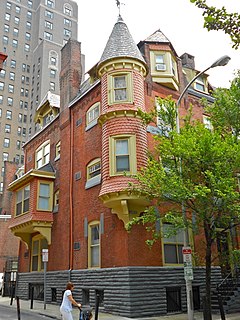
Hockley Row – also known as Evans Row or Victoria House – is a set of four architecturally significant rowhouses, located in the Rittenhouse Square West neighborhood of Philadelphia, Pennsylvania.

Horace Jayne House (1895) is an architecturally significant building designed by architect Frank Furness in Philadelphia, Pennsylvania. It is located at the southwest corner of 19th and Delancey Streets, about a block south of Rittenhouse Square.

Walnut–Chancellor Historic District is a national historic district located in the Rittenhouse Square West neighborhood of Philadelphia, Pennsylvania. It encompasses 51 contributing buildings located one block east of Rittenhouse Square. It includes 4 1/2- to 5-story monumental residences in the Italianate style; brick rowhouses dated to the 1860s-1870s, some with mansard roofs and dormers; and 19th century carriage houses. Located in the district is the Thomas Hockley House (1875), designed by architect Frank Furness (1839-1912).
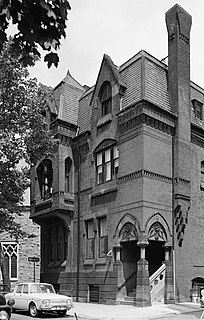
The Thomas Hockley House (1875) is a Victorian city house in Philadelphia, Pennsylvania, designed by architect Frank Furness. Located west of Rittenhouse Square, it is a contributing property in the Walnut–Chancellor Historic District.

























